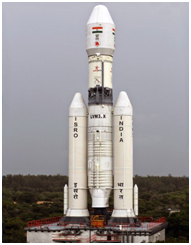ISRO’s cryogenic engine, indigenously developed for LVM3 passes the test
Context
In a recent test, ISRO has increased the carrying capacity of its LVM3 (GSLV Mk-III) rocket by 450 kg with additional propellant loading of its cryogenic engine CE20.
About
Highlights of the Test:
- The CE20 cryogenic enginewas indigenously developed for LVM3 has been subjected to successful hot test at an uprated thrust level of 8 tonne for the first time.
- In addition to this 3D printed LOX and LH2 turbineexhaust casings were also been inducted in the engine for the first time.
- The Indian space agency has made some major modifications carried out on this test article compared to the previous engines which made introduction of Thrust Control Valve (TCV) for thrust control.
- During this test the engine operated with about 20t thrust level for first 40seconds, and then thrust level was increased to 8t by moving the thrust control valve.

|
Do you know? Currently, the LVM3 rocket has a capacity to carry four ton to geo transfer orbit and 10,000 ton low earth orbit. |
Features of LVM3 rocket:
|
Function |
Medium-lift launch vehicle |
|
Manufacturer |
Indian Space Research Organisation |
|
Country of origin |
India |
|
Cost per launch |
?500 crore (US$63 million) |
- The Launch Vehicle Mark-3(LVM 3) previously referred to as the Geosynchronous Satellite Launch Vehicle Mark III (GSLV Mk3) is a three-stage medium-lift launch vehicle.
- It was primarily designed to launch communication satellites into geostationary orbit.
- The cryogenic upper stage of the LVM3 vehicle (C25 stage) is powered by a CE-20 engine working with liquid oxygen and liquid hydrogen (LOX-LH2) propellants combination.
- The LVM3 rocket is the one that is used by ISRO to launch third party satellites on commercial terms.





